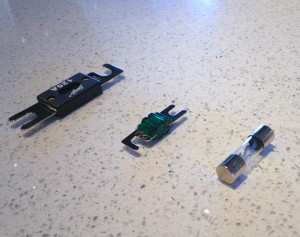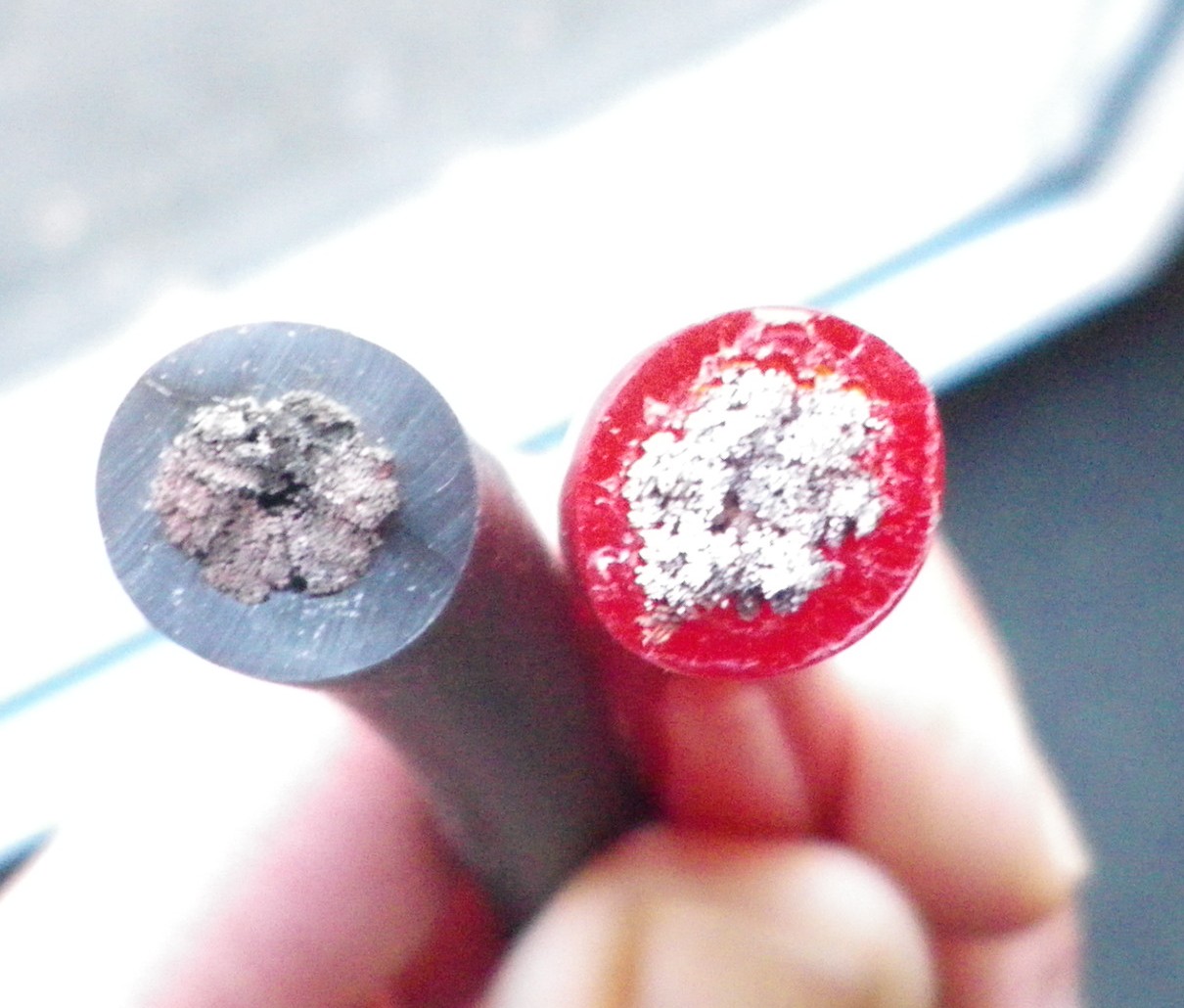
How to buy the right amplifier wiring kit for your car audio amplifier. Determining the proper gauge wire for your amplifier, fuse size, wire length and more.
How the quality of your car audio amplifier wiring can effect your whole car stereo system.
Estimated read time: 6 minutes 15 seconds. Want to read later?
So you just got your amp and your sub and now you need to hook it up. How do you know what gauge wire you need for your amp? What size fuse do you need for your inline fuse holder? How much wire do you need?
Many amp kits are labeled with wattage ratings on them to entice you to buy, but what’s actually on the package is not always the whole story. A basic rule of thumb is this. For up to 500 watts RMS, 8 gauge is sufficient. In the 500 – 1000 watt RMS range, you want to run 4 gauge. From 1000 – 1500 watts RMS you should be running 2 gauge. Over 1500 watts RMS you need 0 gauge and a few other wiring and vehicle upgrades.
Not every wire is created equally. Take a look at the picture above. One is Stinger 4 gauge wire and it runs $2.99 a foot. The other is DB Link 4 gauge and it runs $1.99 a foot. What’s the difference? Why should you buy the more expensive amplifier power wire? Take a closer look at it.
The cheap amplifier wiring has some silver mixed in the strands. That silver wire you see mixed in with the copper is aluminum. Maybe you haven’t heard, but aluminum is not nearly as conductive as copper. This means the cheaper power wire is not capable of carrying as much current as the Stinger power wire which is 100 % oxygen free copper wire. The other important thing to note here is the difference in the shielding. The cheaper stuff has much less shielding. The other tell tale quality difference which you can’t really see, but can easily feel, is the weight of the wire. The cheap DB Link wire is feather light compared to the real copper wire. A good quality amp kit should be pretty heavy. A decent 4 gauge kit with RCA, fuse, fuse holder and 20 feet of wire usually weights around 8-10 lbs.
The weight difference has a lot to do with the wire being 100 percent oxygen free copper, which is heavier than aluminum, and also has to do with having more strands of wire. You can see the Stinger wire has more strands and they are tighter and more compact. The cheaper DB Link wire at $1.99 a foot, with less wire and more aluminum, is as effective as a decent 8 gauge wire. And guess how much a decent 8 gauge wire goes for: $1.49 per foot.
When it comes to amplifier wiring for your car stereo system, don’t cheap out. Don’t you want to get all the power you paid for? If your amp is capable of 1000 watts RMS then it requires 4 gauge wire. Give it what it needs. If you don’t, you end up starving your amp for power. When you restrict the output that your amp is capable of you risk clipping the amp, which causes distortion which can blow your speakers. Besides using the proper gauge power and ground wire for your car audio amplifier, you also need to get the right size fuse for your inline fuse holder.
How do you know what size fuse to use at the battery on your inline fuse holder? Easy. What size fuses are on your amp? If you have two 30 amp fuses on the side of your amp, you would want to have a 60 amp inline fuse on your power wire. If you had two 40 amp fuses, you’d want to get an 80 amp inline fuse. This is kind of important because fuses are only available in certain sizes and in certain styles. Glass cylinder style fuses (also known as AGU Fuses) are usually available in 40 amp, 60 amp or 80 amp ratings and are usually designed for fuse holders that can accommodate 4 or 8 gauge wire.

The next one up is the MIDI style fuse. The MIDI style fuse has two hooks, one at each end and a small plastic body in the middle. Midi style fuses are usually available in 40 amp, 60 amp, 80 amp, 100 amp, 125 amp, and 150 amp ratings. The fuse holders that are designed for MIDI style fuses are usually designed to accommodate 4 or 8 gauge wire. For larger amperage and larger gauge wire we have ANL style fuses. These are like giant MIDI fuses. They also have two hooks, one at each end and a plastic body in the middle. ANL fuses are usually available in 100 amp, 125 amp, 150 amp, 200 amp, 250 amp and 300 amp ratings. The fuse holders designed for ANL style fuses are usually designed to handle either 0 gauge, 2 gauge or 4 gauge.
So how much wire do you really need anyhow? This is something most amp kits do get right. For your average car, you will need about 17 – 18 feet for power and no more than 3 feet for ground (the shorter the better on the ground wire). It’s always better to have extra than to come up short after going through all of the trouble of running the wire. Larger SUV’s may need closer to 20 feet if you plan on mounting the amplifiers in rear. In our shop, we get creative with our amplifier mounting locations. Even in larger SUV’s, we usually don’t need anything longer than 18 feet for power wire. It’s better to hide the amp (or amps) in a quarter panel or underneath a seat rather than extend power wire all the way to the rear cargo area of a large SUV. For most vehicles, plan on at least 17 feet for power and 2-3 feet for ground.
Tip: you always need to match the gauge or your ground wire with the gauge of your power wire.
Here’s a short and sweet guide to ensure you get the proper size inline fuse and correct gauge power and ground wire for your car stereo amplifier:
#1 Check the fuses on your current amp. Total them up. That’s about what size fuse you need for your inline fuse holder. Note: you can’t always get the same exact rating, just get close to it. Its safer to round the number down to the closest number rather than rounding up.
#2 Know the RMS rating of your car stereo amplifier so you can determine the proper gauge power and ground wire. Here is are some rough estimates that can help you:
- Up to 500 watts RMS = 8 gauge
- 500 – 1000 watts RMS = 4 gauge
- 1000 – 1500 watts RMS = 2 gauge
- 1500 -2000 wats RMS = 0 gauge
Update: Recently a helpful reader named Mike pointed out another very valuable tip in this process: The current capacity of the wire must always be more than that of the inline fuse. If the wire AWG is selected correctly, it shouldn’t be an issue but this is a very important part of the circuit design. After selecting the inline fuse value and wire gauge, it must be verified that the wire actually purchased (and length used) can handle the more current than the inline fuse.
#3 Don’t forget, your power wire must be the same gauge as your ground wire, always.
#4 You will need about 17 – 18 feet of power wire and 2 – 3 feet of ground wire for your average vehicle.
#5 Don’t cheap out! Buy 100 percent oxygen free copper wire. If you buy cheap power and ground wire for your amp you’ll risk starving your amp for power which means you have a higher chance of clipping the amp, thus playing distortion and eventually blowing your speakers. Remember, you get what you pay for. Buy quality power and ground wire.
*Just as a side note, if you’re running 1000 – 1500 watts RMS consider upgrading your alternator or at least installing a capacitor. If you’re running 1500 – 2000 watts RMS then you definitely need to upgrade your alternator, your power wire to the alternator, battery ground wire and chassis ground.
Now that you know what you need, go out and get it and install that car stereo amplifier with confidence! Still not confident after reading this post? Just make a comment or shoot me an email if you have any questions or even if you just need a little reassurance. That’s what I’m here for. Thanks for reading!
